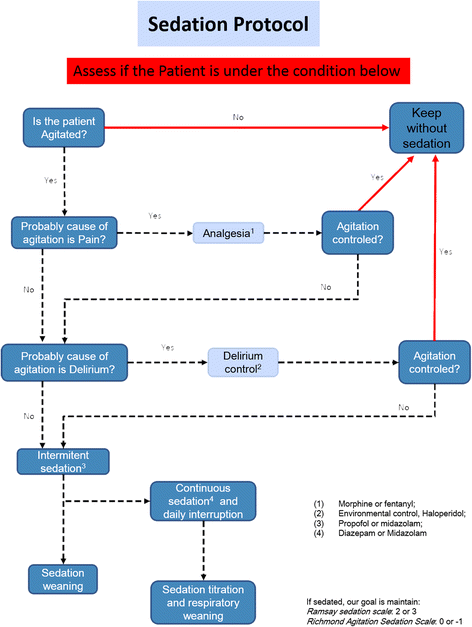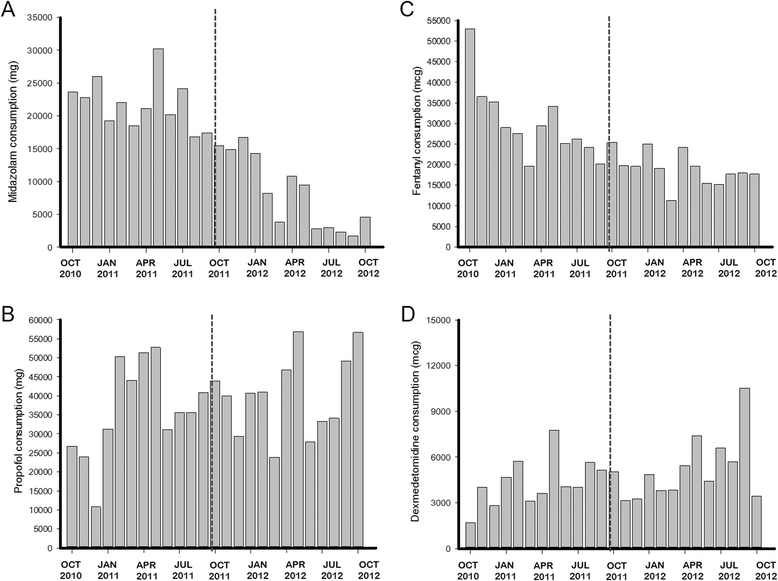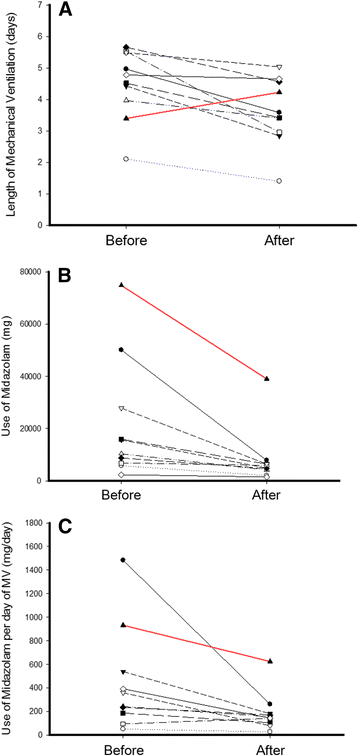Evaluation of a minimal sedation protocol using ICU sedative consumption as a monitoring tool: a quality improvement multicenter project
- PMID: 25673553
- PMCID: PMC4234844
- DOI: 10.1186/s13054-014-0580-3
Evaluation of a minimal sedation protocol using ICU sedative consumption as a monitoring tool: a quality improvement multicenter project
Abstract
Introduction: Oversedation frequently occurs in ICUs. We aimed to evaluate a minimal sedation policy, using sedative consumption as a monitoring tool, in a network of ICUs targeting decrement of oversedation and mechanical ventilation (MV) duration.
Methods: A prospective quality improvement project was conducted in ten ICUs within a network of nonteaching hospitals in Brazil during a 2-year period (2010 to 2012). In the first 12 months (the preintervention period), we conducted an audit to identify sedation practice and barriers to current guideline-based practice regarding sedation. In the postintervention period, we implemented a multifaceted program, including multidisciplinary daily rounds, and monthly audits focusing on sedative consumption, feedback and benchmarking purposes. To analyze the effect of the campaign, we fit an interrupted time series (ITS). To account for variability among the network ICUs, we fit a hierarchical model.
Results: During the study period, 21% of patients received MV (4,851/22,963). In the postintervention period, the length of MV was lower (3.91 ± 6.2 days versus 3.15 ± 4.6 days; mean difference, -0.76 (95% CI, -1.10; -0.43), P <0.001) and 28 ventilator-free days were higher (16.07 ± 12.2 days versus 18.33 ± 11.6 days; mean difference, 2.30 (95% CI, 1.57; 3.00), P <0.001) than in the preintervention period. Midazolam consumption (in milligrams per day of MV) decreased from 329 ± 70 mg/day to 163 ± 115 mg/day (mean difference, -167 (95% CI, -246; -87), P <0.001). In contrast, consumption of propofol (P = 0.007), dexmedetomidine (P = 0.017) and haloperidol (P = 0.002) increased in the postintervention period, without changes in the consumption of fentanyl. Through ITS, age (P = 0.574) and Simplified Acute Physiology Score III (P = 0.176) remained stable. The length of MV showed a secular effect (secular trend β(1) = -0.055, P = 0.012) and a strong decrease immediately after the intervention (intervention β(2) = -0.976, P <0.001). The impact was maintained over the course of one year, despite the waning trend for the intervention's effect (postintervention trend β(3)= 0.039, P = 0.095).
Conclusions: By using a light sedation policy in a group of nonteaching hospitals, we reproduced the benefits that have previously been demonstrated in controlled settings. Furthermore, systematic monitoring of sedative consumption should be a feasible instrument for supporting the implementation of a protocol on a large scale.
Figures






Similar articles
-
Clinical sedation scores as indicators of sedative and analgesic drug exposure in intensive care unit patients.Am J Geriatr Pharmacother. 2007 Sep;5(3):218-31. doi: 10.1016/j.amjopharm.2007.10.005. Am J Geriatr Pharmacother. 2007. PMID: 17996661
-
Dexmedetomidine vs midazolam or propofol for sedation during prolonged mechanical ventilation: two randomized controlled trials.JAMA. 2012 Mar 21;307(11):1151-60. doi: 10.1001/jama.2012.304. JAMA. 2012. PMID: 22436955 Clinical Trial.
-
A Pediatric Sedation Protocol for Mechanically Ventilated Patients Requires Sustenance Beyond Implementation.Pediatr Crit Care Med. 2016 Aug;17(8):721-6. doi: 10.1097/PCC.0000000000000846. Pediatr Crit Care Med. 2016. PMID: 27355825
-
Optimal intravenous dosing strategies for sedatives and analgesics in the intensive care unit.Crit Care Clin. 1995 Oct;11(4):827-47. Crit Care Clin. 1995. PMID: 8535981 Review.
-
[Sedation of patients with respiratory failure in ICU].Pneumologia. 2012 Oct-Dec;61(4):240-4. Pneumologia. 2012. PMID: 23424950 Review. Romanian.
Cited by
-
Sedation protocols versus daily sedation interruption: a systematic review and meta-analysis.Rev Bras Ter Intensiva. 2016 Oct-Dec;28(4):444-451. doi: 10.5935/0103-507X.20160078. Rev Bras Ter Intensiva. 2016. PMID: 28099642 Free PMC article.
-
Statistical analysis of a cluster-randomized clinical trial on adult general intensive care units in Brazil: TELE-critical care verSus usual Care On ICU PErformance (TELESCOPE) trial.Rev Bras Ter Intensiva. 2022 Jan-Mar;34(1):87-95. doi: 10.5935/0103-507x.20220003-pt. Rev Bras Ter Intensiva. 2022. PMID: 35766658 Free PMC article. Clinical Trial.
-
TELE-critical Care verSus usual Care On ICU PErformance (TELESCOPE): protocol for a cluster-randomised clinical trial on adult general ICUs in Brazil.BMJ Open. 2021 Jun 21;11(6):e042302. doi: 10.1136/bmjopen-2020-042302. BMJ Open. 2021. PMID: 34155070 Free PMC article.
-
Update on the Epimed Monitor Adult ICU Database: 15 years of its use in national registries, quality improvement initiatives and clinical research.Crit Care Sci. 2024 Sep 2;36:e20240150en. doi: 10.62675/2965-2774.20240150-en. eCollection 2024. Crit Care Sci. 2024. PMID: 39230140 Free PMC article. Review.
-
Organizational characteristics, outcomes, and resource use in 78 Brazilian intensive care units: the ORCHESTRA study.Intensive Care Med. 2015 Dec;41(12):2149-60. doi: 10.1007/s00134-015-4076-7. Intensive Care Med. 2015. PMID: 26499477
References
-
- Barr J, Fraser GL, Puntillo K, Ely EW, Gélinas C, Dasta JF, Davidson JE, Devlin JW, Kress JP, Joffe AM, Coursin DB, Herr DL, Tung A, Robinson BR, Fontaine DK, Ramsay MA, Riker RR, Sessler CN, Pun B, Skrobik Y, Jaeschke R. Clinical practice guidelines for the management of pain, agitation, and delirium in adult patients in the intensive care unit. Crit Care Med. 2013;41:263–306. doi: 10.1097/CCM.0b013e3182783b72. - DOI - PubMed
-
- Salluh JI, Soares M, Teles JM, Ceraso D, Raimondi N, Nava VS, Blasquez P, Ugarte S, Ibanez-Guzman C, Centeno JV, Laca M, Grecco G, Jimenez E, Árias-Rivera S, Duenas C, Rocha MG, the DECCA (Delirium Epidemiology in Critical Care) Study Group Delirium epidemiology in critical care (DECCA): an international study. Crit Care. 2010;14:R210. doi: 10.1186/cc9333. - DOI - PMC - PubMed
Publication types
MeSH terms
Substances
LinkOut - more resources
Full Text Sources
Other Literature Sources

